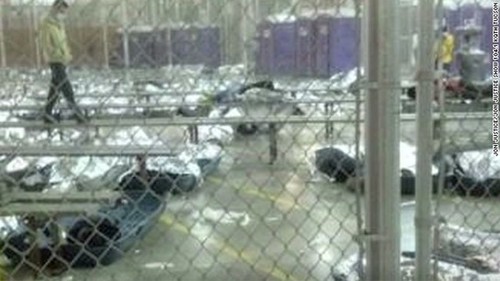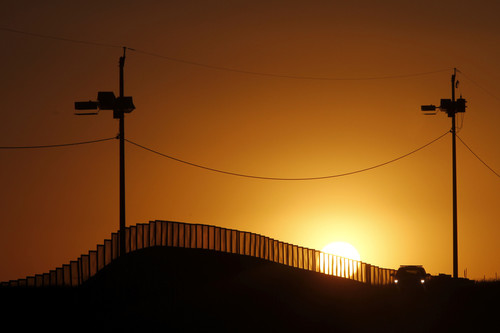Source: documentedthefilm.com
Border walls
The process Congress wants to use for child migrants is a disaster
A secret UN report obtained by Vox reveals Border Patrol agents are failing to protect Mexican children.
…
Mexican children are treated differently than Central American children at the border
…
BY LAW, AGENTS SHOULD ASSUME CHILDREN ARE IN DANGER; IN PRACTICE, AGENTS ASSUME THEY’RE NOT
…
It’s not that Central American kids need to be protected less; it’s that Mexican kids need to be protected more
Source: www.vox.com
Jose Antonio Vargas Detained by Border Patrol – COLORLINES
Vargas has been taken into custody at the McAllen Border Patrol Station.
Click through to read more.
Source: colorlines.com
I wonder if the Border Patrol knows who they are messing with?
Border Angels – The Power of One
Since 1994, 10,000 people have died trying to cross the border between the United States and Mexico, according to Enrique Morones founder of Border Angels. Among those who attempted the journey are men, women and young children. Due to harsh weather conditions, tough terrain and often the expensive price migrants must pay to smugglers, however, many do not make it across.
Founded by Morones in 1986, Border Angels is a non-profit organization dedicated to providing humanitarian assistance to undocumented immigrants. After bringing food and water to migrants who were living in the canyons of North County San Diego, Morones and the Border Angels expanded their operation by going out to the desert to place water near the recently constructed wall dividing the United States and Mexico, also known as Operation Gatekeeper.
“Before Operation Gatekeeper, one or two people died every month,” said Morones.
“After Operation Gatekeeper, one or two people die every day.”
Click through to read more.
Source: misaelvirgen.blogspot.com
Children from Central America – Origins of Crisis
Over the last year, an unprecedented number of unaccompanied immigrant children, mostly from Central America, have attempted to cross the border into the United States. Antonio Gonzalez, president of the William C. Velasquez Institute,explains the roots of the migration surge and the politics behind it.
Source: www.tavissmileyradio.com
An in depth explanation of the origins of the crisis that has lead children to flee to the U.S.
Eleven minutes of audio.
One point Gonzalez had wrong is that the crisis started back in 2009, years longer than the one year that he suggested.
“Welcome To Hell”: The Border Patrol’s Repeated Abuse Of Children
Detainees wrested from sleep every 30 minutes, the lights in their frigid cells never turned off. One detainee told by officials, don’t lie or you’ll be raped. Another detainee sexually abused by guards. Detainees forced to stand in stress positions. Others denied adequate food, water, and medical treatment and held in dehumanizing conditions. “Welcome to hell,” one guard told a detainee, a good metaphor for what occurs across these sites of torment.
These incidents don’t come from military prisons in Iraq or Afghanistan or CIA black sites. This has been happening for years along the Southwest border in U.S. government facilities run by U.S. Customs and Border Protection (CBP) and its Border Patrol. The victims: children, some as young as infants, as documented in arecent complaint filed by a group of immigrant rights advocates who interviewed 116 unaccompanied children previously held in CBP custody.
Just as appalling, government agencies have known about these abuses for a long time, but failed to take action. Now, more children are vulnerable to harm in Border Patrol custody than ever before. Since October, 47,000 children have left their homes in Central America, mainly in El Salvador, Guatemala, and Honduras, for the United States. They flee destabilizing violence and crime fomented by criminal syndicates and gangs, more often than not without a loved one leading the way. With their fate far from certain, they make an arduous, perilous trek, sometimes spanning thousands of miles, in search of refuge in America. They risk it all, not so much in search of a better life, but simply to live.
Once here, many of these brave and resourceful children — who have already suffered abuse many times before throughout their lives — encounter not compassion and empathy from U.S. immigration officials but abuse. The most vulnerable are once again taught a cruel lesson: There’s nowhere safe for them to lay their heads down and just be children.
The advocates’ interviews with unaccompanied children are chilling.
One in four detained children reported physical abuse at the hands of CBP, including sexual assaults and beatings. More than half reported verbal abuse, including racist and sexist insults and even death threats, as well as the denial of urgent medical care. In one instance, a 14-year-old girl’s asthma medication was confiscated. She subsequently suffered multiple asthma attacks. After the first attack, CBP officials threatened her, telling her she better not be faking or else.
Seven out of ten interviewed reported detentions lasting longer than the 72-hour period mandated by law. Three out of ten children reported that their belongings were confiscated and never returned. Many others reported being shackled during transport, the metal restraints excruciatingly digging into their wrists and ankles. Eighty percent reported CBP personnel denied them adequate food and water.
Sometimes the cruelty shocks the conscience.
One 17-year-old girl, soaking wet, was placed in a frigid holding cell, which detained children commonly referred to as the hielera, or the freezer. Her only drinking water came from the toilet tank. When she had to use the toilet, she found herself exposed to other detainees and a wall-mounted security camera.
Click through to read more.
Source: www.huffingtonpost.com
Why 90,000 Children Flooding Our Border Is Not an Immigration Story
Virtual cities of children are fleeing their homes. This is a lot bigger than U.S. border control, a United Nations protection officer explains.
Source: www.nationaljournal.com
Feds made humanitarian crisis worse
Immigration officials were caught in an untenable position. And then they made it worse.
Unaccompanied minors from Central America, as well as mothers with young children, have been crossing the Rio Grande into south Texas in vast numbers this year. Increasing gang violence in their home countries incredibly makes the long trek across Mexico a safer alternative. Some seek to reunite with parents who already crossed the border. Human smugglers promise a land of milk and honey.
They’re not heading for California, Arizona or west Texas. Those sectors of the border have been fortified. Even desperation cannot push a child into a deadly desert. Instead, they’ve targeted the most lightly guarded section of the border, where a nearly dry river is easily crossed into south Texas.
Once over, they are quickly caught, apparently part of the plan.
The Border Patrol and Immigrations and Customs Enforcement are trapped. Then, because secrecy is engrained in the culture of their parent Department of Homeland Security, they do a poor job of getting out of the trap.
Immigration officials can’t send these children back across the border. They can’t fly them back to Central America once they make a credible claim of fear of violence. They don’t have adequate facilities in south Texas to process the children. They need help.
But instead of acknowledging their problem, instead of reaching out to state leaders in Arizona and California, they surprised them.
The mayor of Nogales, AZ is speaking out about the hundreds of unaccompanied kids at a giant Border Patrol warehouse in Southern AZ. The mayor said the kids are in good care.
In Arizona, it started when families were dropped at bus stations, apparently after being processed at Arizona immigration facilities with greater capacity than those in Texas. Most, it turned out, were bound for other states.
But no one here knew this. A state that bore the brunt of the last surge in illegal immigration feared the worst. It was unconscionable that the Border Patrol and ICE said nothing.
Next came the children, bused into a warehouse of a building in Nogales. Again, the buses showed up out of nowhere, with no warning and no explanation. Hundreds of children were dumped into a building with insufficient beds and showers. If nothing else said crisis, that did.
But again, no explanation. Just that stony silence until reporters started pressing for answers. In the meantime, the vacuum of information invited politicians to puff up their outrage. SB 1070 was born in an atmosphere like this.
Silence and surprises do not serve ICE or the Border Patrol. They do not serve the people of the United States. And they do little for the children bewildered by all they are encountering.
Click through to read more.
Source: www.azcentral.com
Border detention of children shames America
See on Scoop.it – Community Village Daily
Ruben Navarrette says when hordes of youngsters from Central America are being held by the U.S. in reportedly inhumane conditions the nation has lost itself
Click through for video.
See on www.cnn.com
Border agency ousts head of internal affairs, will investigate unit
The head of internal affairs for U.S. Customs and Border Protection was removed from his post Monday amid criticism that he failed to investigate hundreds of allegations of abuse and use of force by armed border agents, officials said.
See on www.latimes.com











